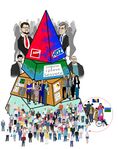LED2LEAP 2021 - Zagreb Team 1
>>>back to working groups overview
For help with editing this Wiki page use this link.
For assignments and key readings use this link.
Landscape Democracy Rationale
- insert text here
Location and Scope
Vuger Valley is situated in the eastern part of Zagreb, where it flows from the nature park Medvednica (which is located up north), through Sesvete and its surrounding settlements, and ends with the river Sava.
The biggest settlement in the Vuger Valley is Sesvete, a city district in the eastern part of Zagreb. It is a mixture of urbanized landscape and traditional rural areas due to its position between Zagreb and surrounding settlements. This position, as well as major traffic lanes, mark it as a transitional zone with a lot of traffic going through every day.
Phase A: Mapping Your Community
Welcome to Your Community and Their Landscape
- The area of Vuger Valley has 3 main landscape types – natural, rural/traditional and urban/industrial. The rural areas with active agricultural fields and traditional smaller houses can be found up north from Sesvete, while the center and south of Sesvete are more urban and industrial with apartment buildings, industrial complexes, and shopping centers.
The different types of landscapes, as well as different levels of urbanization, have affected the Vuger stream as well. Its characteristics change from being a completely natural stream up north to a channelized stream majority of the flow. The Vuger stream has a lot of tributaries that were formerly used for agricultural irrigation and mills. But now they face degradation and pollution due to neglect and inappropriate maintenance.
As the biggest settlement in the Vuger Valley, Sesvete was chosen as the scope for landscape democracy research topic. The Sesvete city district occupies 26% of the City of Zagreb and is home to 9% of the population. It is the largest city district considering its area and population. The spatial distribution of inhabitants is not uniformed, the urban part having a much bigger population than the rest of the district of Sesvete. The average age is 38 years since it’s populated mainly by younger families. The share of the highly educated population is 14%, 20% has primary, and 57% secondary education. The population of Sesvete started to grow in the 1970s when newcomers from Bosnia begin to migrate to Sesvete. Also, the population of the City of Zagreb started to decline in the 1990s (post-war) while the population of Sesvete continues to grow. The main challenges are identity conflict(s) and antagonism among different communities who live in Sesvete (e.g., native inhabitants from Prigorje and newcomers from Bosnia)
Groups of Actors and Stakeholders in Your Community
Sesvete has cultural differences between communities, which makes it rich in diversity. It is a result of influences from different cultures, industrialization, and wars throughout history. The most prominent groups are the native people from Prigorje, the Roma community, and Bosnian and Herzegovinian settlers. Religion, socioeconomic status, and age formed multilayered communities which encompass all ethnic groups; seniors and people with disabilities, families, the Church, and other religious communities, as well as Non-government organizations.
Relationships Between Your Actors and Groups
Society in Croatia, in general, is one of deep division on many levels, and the communities in Sesvete are no different. Be it on an ethnic basis, political views, age differences, social or economical status. It’s as if people have an easier time finding their differences than common ground. Regarding Sesvete, the most prominent are identity conflicts, differences between socio-economical status, and political views between the native residents from Prigorje, Bosnian settlers, the Roma community, and seniors and people with disabilities. These differences and conflicts are manifested in mutual competition about who has more rights in the community and decision-making. Despite these differences, they do have shared interests, like better stream maintenance and more activities and inclusive contents in open green spaces.
We noticed a system of the power hierarchy in Sesvete, comprised of several layers of community. Such a system produces conflict between the “higher-ups” or government and the general public, mainly caused by corruption in all levels of government and a feeling of exclusion from decision-making. The second one is between the general public and academic society defined by mistrust towards experts. Although the general public has the opportunity to participate in public hearings, they lack the motivation because they see public hearings as charades. In addition, the general public is perceived as incompetent individuals from an expert’s point of view. Since they have extensive knowledge on the issue, the NGOs serve as mediators between the public, experts, and government officials. They also fulfill the role of educators for all those concerned.
Summary of Your Learnings from the Transnational Discussion Panel
- insert text here
Theory Reflection
- insert text here
References
- insert text here
Phase B: Democratic Landscape Analysis and Assessment
The Scene in Your Story of Analysis
- insert text here
The Actors in Your Story of Analysis
- insert text here
The Story of Analysis
- insert text here
Reflect on Your Story of Analysis
- insert text here
Phase C: Collaborative Visioning and Goal Setting
The Scene in Your Story of Visioning
- insert text here
The Actors in Your Story of Visioning
- insert text here
The Story of Visioning
- insert text here
Reflect on Your Story of Visioning
- insert text here
Phase D: Collaborative Design, Transformation and Planning
Your Prototyping Action
- insert text here
The Evolution of Your Prototyping Action
- insert text here
The Plan Behind Your Prototyping Action
- insert text here
The Realization of Your Prototyping Action
- insert text here
Reflect on Your Prototyping Action
- insert text here
Phase E: Collaborative Evaluation and Future Agendas
Collaborative Evaluation and Landscape Democracy Reflection
- insert text here
The Actors in your Collaborative Evaluation
- insert text here
Reflection on the Online Seminar
- insert text here
Reflection on the Living Lab Process
- insert text here
Your Living Lab Code of Conduct
- insert text here
Process Reflection
- insert text here


























